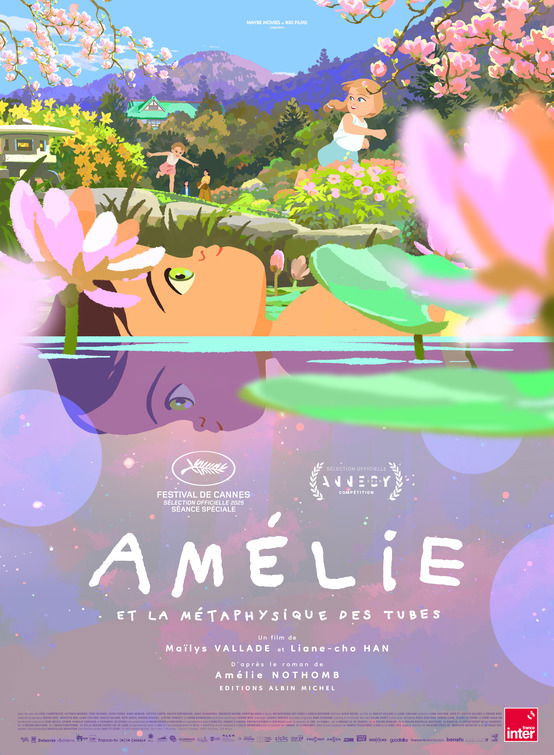“A Beautifully Made Tale About the Sanctity of Life”

| None | Light | Moderate | Heavy | |
|---|---|---|---|---|
| Language | ||||
| Violence | ||||
| Sex | ||||
| Nudity |
What You Need To Know:
LITTLE AMÉLIE OR THE CHARACTER OF RAIN is based on an autobiographical memoir. As such, it’s an emotionally resonating French movie about the meaning of life and death. It has a strong pro-life message about friendship, a nuclear family and appreciating the world’s beauty. The animation and writing are high quality and downright gorgeous. However, LITTLE AMÉLIE OR THE CHARACTER OF RAIN has brief violence, some Japanese spiritualism, and references to nuclear bombings. Due to this content and its heavy subject matter, MOVIEGUIDE® advises strong or extreme caution for mature, older viewers.
Content:
Strong moral pro-life worldview based partly on Christianity but with some Japanese spiritualism, title character embodies the virtues of friendship and opens her heart to others, she also becomes “pro-life” and decides to not take her time with her friends for granted, there’s a strong nuclear family with a caring mother and father, the adults discuss the lingering scars of a post-World War II Japan, title character and her friends discuss being able to see their relatives in a purgatory or the afterlife, and characters discuss the process of losing loved ones and healing with time, but the heroine envisions herself as God (in a theistic way) when she’s very young because everything revolves around her, and she pretends to manipulate the weather with her supernatural powers, she also briefly envisions herself being a spirit lost in purgatory, and she and her friends discuss being able to see their deceased relatives in the afterlife, plus there’s some false Japanese spiritualism/superstition where the title character’s caretaker reads her a book of Japanese folktales about yokai (a sort of catchall term for Japanese ghosts, demons, monsters, shapeshifters, tricksters, spirits, supernatural beings, or other mysterious phenomena), and Amélie imagines in one scene seeing such a creature walk across her house;
No foul language;
Brief violence throughout, but no blood or gore, a girl chucks her wooden block through a window, the heroine gets into a slapping match with her older brother, the heroine almost drowns to death by the beach, a girl slips and gets a concussion to her head (but she survives), a grandmother dies from natural causes off screen, a woman describes her experience barely surviving a nuclear blast during World War II (but no flashbacks are shown), and a woman states she was almost burned to death;
No sexual content;
A 2-year-old girl is shown topless while bathing at the beach and in the forest, but otherwise no nudity;
No alcohol use;
No smoking or drugs; and,
A landowner holds onto her prejudice against the Allied bombings that eliminated her family in World War II, the same landowner threatens to kick her Belgian neighbors off her property, and the title character teases her older brother for being mean to her.
More Detail:
LITTLE AMÉLIE is based on an autobiographical novel by Amélie Nothomb. It’s set in late 1960s Japan. Amélie is a shy yet melancholic 2-year-old who lives with a family of Belgium diplomats. Amélie is reluctant to experience Japanese culture. When she meets her father’s Japanese friend, Nishio-san, for the first time, the young girl is excited to learn the beauty of the world. However, a family death causes the newborn Belgian to spiral into depression. Will Amélie be able to find peace?
LITTLE AMÉLIE is an excellent showcase of hand-drawn animation. The shot composition, lighting and weather effects are incredible. The movie’s greatest strength is its warm and deep color choice. The art direction is clean, natural and deserves to be studied in any art class. The writing and voice acting are also great. The movie is able to balance the liveliness of childhood curiosity with the grief of losing loved ones. The filmmakers treat the viewers with maturity and respect.
THE CHARACTER OF RAIN has a strong moral worldview with Japanese spiritualism and Christian elements. Amélie herself overcomes her shyness and develops a strong friendship with her neighbor, Nishio-san. The heroine chooses a “pro-life” stance, begins to appreciate the beauty of the world, and lives with a strong traditional family. However, when she’s very young, she imagines herself being “God,” because everything seems to revolve around her, and she pretends to command earthquakes and the Sea of Japan. She briefly envisions herself being a spirit lost in purgatory. The movie has no references to Jesus or prayer. However, the heroine and her friends discuss being able to see their deceased relatives in the afterlife.
The movie is free of foul language and sexuality, but it has brief violence and a serious discussion over the nuclear bombings of World War II. The heroine almost drowns by the sea and hits her head on a stone. There is naturalistic female nudity, where Amélie (a two-year-old) is shown topless in at least three scenes (at a bathtub, in the forest and at the beach). Amélie almost gets into a fist fight with her older brother, who constantly teases her shy demeanor.
The characters have a difficult discussion about the Allied bombings of Japanese citizens during World War II. Several characters mention holding prejudice against the Belgians and the Allied Forces for letting the bombings happen. The movie doesn’t sugarcoat the experience of loss and grief. In fact, it does a great job exploring these themes. However, it will be overwhelming to children and other sensitive viewers.
LITTLE AMÉLIE OR THE CHARACTER OF RAIN is an emotionally resonating French movie about the meaning of life and death. It has a strong message about friendship, a nuclear family and appreciating the beauty of the world. The animation and writing quality are downright gorgeous. However, LITTLE AMÉLIE has some brief violence, Eastern spiritualism, and references to nuclear bombings. For example, Amélie’s caretaker briefly reads her a book of Japanese folktales about yokai, a sort of catchall term for Japanese ghosts, demons, monsters, shapeshifters, tricksters, spirits, supernatural beings, or other mysterious phenomena, and Amélie imagines in one scene seeing such a creature walk across her house. Also, Amélie makes reference to possibly meeting her loved ones in purgatory or the afterlife. So, MOVIEGUIDE® advises strong or extreme caution for mature, older viewers.


 - Content:
- Content: 

